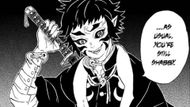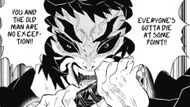There’s hardly any line between ally and enemy for Kaigaku in Demon Slayer. His legacy in the series is scarred by cowardice and ambition. He has a twisted journey; while not as prominently featured as the main villains, his actions ripple throughout the series.
His origins are steeped in wasted talent. Kaigaku is a supporting antagonist holding the position of Upper Rank Six (in the Infinity Castle Arc) and also a former Demon Slayer. He trained alongside Zenitsu Agatsuma under Jigoro Kuwajima, the retired Thunder Hashira. Kaigaku mastered six Thunder Breathing forms with ease, overshadowing Zenitsu’s struggle.
Before joining the Demon Slayer Corps, Kaigaku was an orphan under the care of Gyomei Himejima at his temple. His survival-at-all-costs mentality was established early when he committed an unforgivable act—extinguishing the wisteria incense at the temple and letting a demon in, sacrificing the other orphans to save himself.
But his skills bred arrogance. When confronted by a demon he couldn’t defeat, Kaigaku chose survival over honor, accepting Muzan Kibutsuji’s blood to become a demon. This act of betrayal not only shattered his bond with Jigoro.

After becoming a demon, Kaigaku quickly rose through the ranks, replacing Daki and Gyutaro to become the new Upper Moon Six of the Twelve Demon Moons. His appearance changed dramatically—his skin turned pale gray, black claw-like marks appeared on his cheeks, and his eyes displayed the Upper Six kanji symbol.
Kaigaku, now wielding black lightning fueled by demonic energy, mocks Jigoro’s teachings as “weak.” In contrast, Zenitsu’s mastery embodies a warrior defending his master’s honor.
As a former Demon Slayer, Kaigaku’s betrayal cuts deeper than most villains. Demons are not born monsters but broken humans. Kaigaku’s choice to embrace power over humanity forces the Corps to confront their own vulnerability.

Kaigaku's story reaches its climax during the Infinity Castle Arc, where he faces off against his former junior, Zenitsu. During their confrontation, Zenitsu reveals that their master, Jigoro, had committed seppuku to atone for Kaigaku's betrayal. Rather than showing remorse, Kaigaku laughs and expresses satisfaction at his former master's death.
Despite Kaigaku's enhanced demonic powers and five Thunder Breathing forms, Zenitsu ultimately defeats him using the Seventh Form: Flaming Thunder God—a technique Zenitsu created himself. Their fight strips away Zenitsu’s comic-relief persona, revealing a hero grappling with grief and rage.
A Legacy of Bitterness, Not Redemption in Demon Slayer
Unlike tragic demons like Akaza or Rui, Kaigaku dies without remorse. His final moments in Demon Slayer are marked by denial, refusing to acknowledge Zenitsu’s victory or his own failures. This lack of redemption cements him as a cautionary symbol—someone who traded his soul for power and gained nothing.

His arc mirrors Muzan and Kokushibo’s, showcasing how fear and pride can corrupt even the gifted. For the Corps, he represents their worst fear—a comrade turned predator. Yet his defeat also reaffirms their creed: humanity’s light persists through unity and sacrifice.
To sum up, Kaigaku in Demon Slayer personifies the cost of selfishness in a world where demons and slayers alike are shaped by choices. For Zenitsu, defeating Kaigaku is a promise to uphold the ideals his master and the Corps stand for. In Demon Slayer, Kaigaku’s story lingers as a battle against the darkness within.
